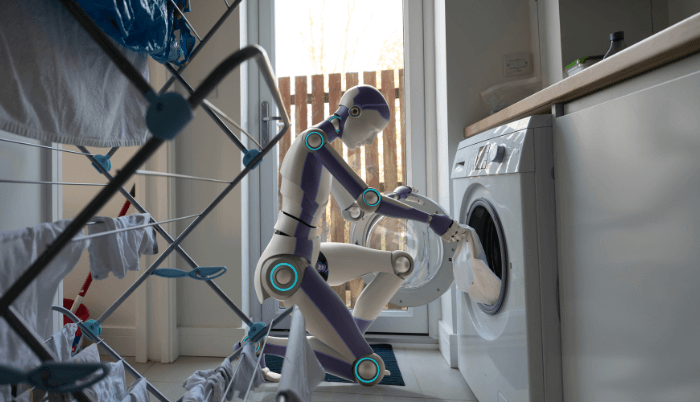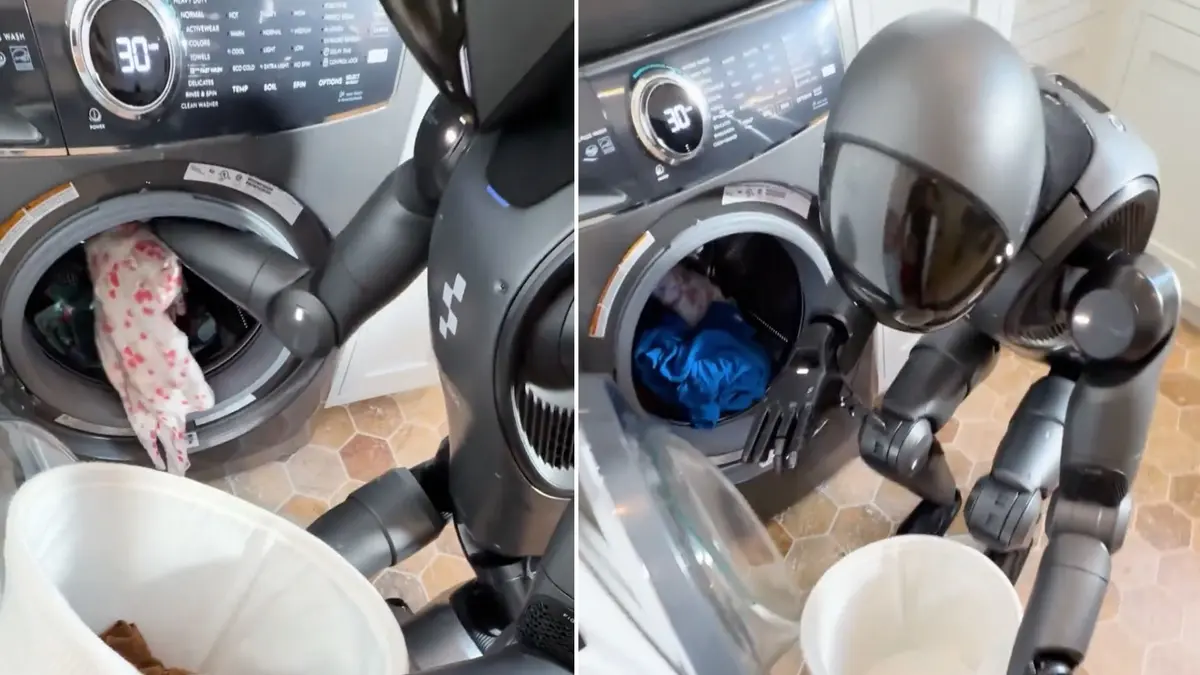In an astonishing leap toward real world automation, a video of a robot doing laundry has taken the internet by storm. Shared by Figure AI’s CEO Brett Adcock, the clip shows Figure 02, a highly advanced humanoid robot, lifting garments from a basket and placing them into a washing machine smoothly and confidently. While it doesn’t yet manage the full cycle independently, the progress it demonstrates is nothing short of revolutionary.
Robot Doing Laundry Grabs the World’s Attention
We’re now witnessing something that once only existed in futuristic films a robot doing laundry in a real home environment. This particular moment reflects a pivotal shift in domestic robotics, where machines are no longer confined to industrial settings. Instead, they’re being designed to handle daily household tasks with growing precision and adaptability.
The viral video instantly drew millions of views, showcasing the potential of AI and robotics merging into everyday life. More importantly, it sparked conversations on what happens when machines begin to master the mundane.
What Makes Figure 02 Stand Out?
Figure 02 is not just another tech prototype. It’s a sophisticated, AI integrated humanoid robot that can perform adaptable, real world tasks like dishwashing, folding clothes, and sorting items. The fact that it’s a robot doing laundry today hints at a future where robotic assistants become common in every home.
Advanced Capabilities of Figure 02, Real time object recognition and manipulation AI driven decision making, not just pre-programmed sequences. Flexible joints and hands, allowing it to handle soft fabrics, Natural motion control, mimicking how humans perform tasks. According to Figure AI’s CEO, the company’s vision is to build a general purpose robot that can learn any human task, and laundry is one of the most relatable places to start.
Why This Is a Big Deal
Dr. Rodney Brooks, co founder of iRobot and former director at MIT CSAIL, commented on the video, The idea of a robot doing laundry in an unstructured environment shows how far we’ve come. The challenge wasn’t the arms or sensors it was the reasoning behind what clothes are, how they move, and how to interact with them.
Meanwhile, robotics ethicist Kate Darling shared concerns and optimism. This isn’t just about labor replacement. For people with physical impairments, a robot doing laundry could restore independence. But we must be careful in shaping the rules of engagement these machines learn from us. These insights reveal that the significance isn’t just technological it’s also social and ethical.
Japan’s Push for Domestic Robotics
In Japan, robots have long been integrated into elder care and customer service. SoftBank’s Pepper and Toyota’s HSR (Human Support Robot) have been deployed in both hospitals and homes. However, the majority of these robots lacked the dexterity to perform soft tasks like folding laundry or loading washers.
Figure 02 marks a change. With its AI reasoning and motion stability, the robot doing laundry today could eventually serve Japan’s rapidly aging population, filling a crucial labor gap while maintaining dignity and assistance at home.

The Emotional Impact
Watching the video of a robot doing laundry, I was struck not just by the tech but the possibilities it represents. My grandmother, now in her late 80s, finds laundry exhausting. If a machine could assist her in daily chores without invading her privacy or dignity, that would be a game changer.
It’s easy to think of robotics as something cold or mechanical, but there’s deep humanity in giving people freedom through intelligent machines.
The Deeper Implications: Are We Ready?
1. Automation vs. Livelihoods
As these robots enter homes, factories, and stores, what happens to those whose jobs revolve around cleaning and maintenance? Companies like Figure AI argue that robots will take over unwanted, repetitive, or unsafe tasks but societal adjustment is still necessary.
2. Safety and Trust
Can a robot that handles delicate clothes also be trusted around children or pets? There’s a growing field of AI ethics and robotic safety, working to ensure these systems don’t cause harm even unintentionally.
3. Affordability
The biggest question will this tech be accessible? As of now, humanoid robots cost hundreds of thousands of dollars. But history shows that innovation leads to affordability just like smartphones, electric cars, and even home appliances.
What’s Next for Home Robots?
Brett Adcock hinted at more to come. Future models may be able to, Operate multiple home appliances independently, Sort laundry by color or fabric, Fold and organize clothes, Detect stains and recommend cleaning cycles.
While the robot doing laundry today still needs assistance to start a washing cycle or add detergent, it’s only a matter of time before these tasks become fully autonomous.
From Viral Clip to Visionary Future
The moment Figure 02 picked up laundry, it picked up more than clothes it picked up humanity’s dreams of freedom, innovation, and intelligent companionship. A robot doing laundry doesn’t just represent technological prowess it represents possibility.
We’re standing at the edge of a future where robots will not just clean our homes, but care for our well being, reduce daily stress, and offer independence to those who need it most. The laundry room may just be the first step toward a fully robotic home.

